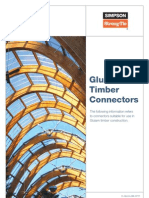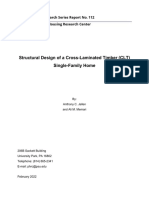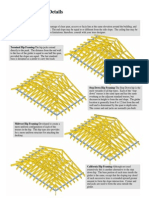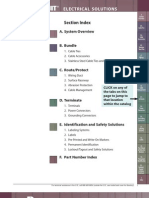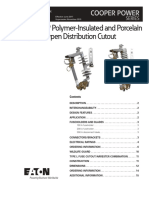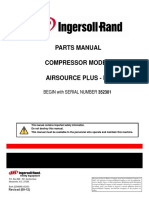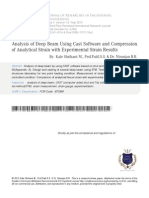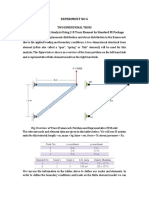At a glance
Powered by AI
Proper connection details are important for the structural performance and serviceability of timber structures. Glulam connections require careful consideration of wood properties like moisture-related expansion/contraction to prevent issues like tension perpendicular to grain stresses. Connections also must be designed to transfer loads without stress concentrations that could lead to failure.
Glulam Connection Details
CONSTRUCTION GUIDE
Form No. T300J
■
© 2016 APA – The Engineered Wood Association
■
www.apawood.org
2
Glulam Connection Details Construction Guide
2
Glulam Connection Details
Proper connection details are important to the structural
performance and serviceability of any timber-framed structure.
While this is true for solid sawn as well as glued laminated
(glulam) timbers, the larger sizes and longer spans made pos-
sible with glulam components make the proper detailing of
connections even more critical. Careful consideration of mois-
ture-related expansion and contraction characteristics of wood
is essential in detailing glulam connections to prevent induc-
ing tension perpendicular-to-grain stresses. Connec tions must
be designed to transfer design loads to and from a structural
glulam member without causing localized stress concentra-
tions, which may initiate failure at the connection.
It’s also important to design connections to isolate all wood members from potential sources of excessive moisture. In
addition to accentuating any connection problems related to
expansion or contraction of the wood due to moisture cycling,
equilibrium moisture content in excess of approximately 20 percent may promote the growth of decay-causing
organisms in untreated wood.
This guide from APA illustrates a variety of connections that
are common in timber-frame construction.
CONTENTSBEAM-TO-BEARING
...........................
5FOUNDATION BEARING— POCKET DETAILS
.................................
5BEAM-TO-BEAM
...................................
7BEAM-TO-BEARING— SLOPED END CUT
.............................
10BEAM-TO-BEAM CONNECTIONS USING CONCEALED PLATES
........................
10HEAVY CONCENTRATED LOADS SUSPENDED FROM BEAM
.......................................
11CANTILEVER BEAM CONNECTION— INDEPENDENT TENSION TIE
...........
11CANTILEVER BEAM CONNECTION— WELDED TENSION TIE
.....................
12CANTILEVER BEAM CONNECTION— NO TENSION TIE
..............................
12BEAM-TO-COLUMN— U-BRACKET—WOOD OR PIPE COLUMN
.............................
13BEAM-TO-COLUMN— T-BRACKET
.........................................
14BEAM-TO-COLUMN— WITH TOP LATERAL SUPPORT PLATE
.................................
15NOTCH IN BEAM OVER COLUMN
.................................
15BEAM IN BENT HANGER
..................
16WOOD COLUMN TO CONCRETE BASE
...............................
16GLULAM ARCH TO FOUNDATION
...................................
16TRUSS CONNECTORS
.......................
17TOP CAP FOR HORIZONTAL OR SLOPED MEMBERS
......................
18TOP CAP FOR EXPOSED BEAMS OR VERTICAL MEMBERS
...................
18
Form No. T300J
■
© 2016 APA – The Engineered Wood Association
■
www.apawood.org
3
Glulam Connection Details Construction Guide
DESIGNING AND DETAILING CONNECTIONS FOR SHRINKAGE
Wood expands and contracts as a result of changes in its internal moisture content. While expansion in the direction parallel to grain in a wood member is minimal, dimensional change in the direction perpendicular to grain can be significant and must be considered in connection design and detailing. A 24-inch-deep beam can decrease in depth through shrinkage by approximately 1/8 inch as it changes from 12 to 8 percent in equilibrium moisture content. In designing connections for glulam members, it is important to design and detail the connection such that the member’s shrinkage is not restrained. If restrained, shrinkage of the beam can cause tension perpendicular-to-grain stresses to develop in the member at the connection. If these stresses exceed the capacity of the member, they may cause the glulam to split parallel to the grain. Once a tension-splitting failure has occurred in a member, its shear and bending capacity are greatly reduced.In addition to the moisture-induced tension perpendicular-to-grain failures discussed above, similar failures can result from a number of different, incorrect connection design details. Improper beam notching, eccentric (out of plane) load-ing of truss connections and loading beams from the tension side can induce internal moments and tension perpendic-ular-to-grain stresses.
EFFECTS OF MOISTURE ACCUMULATION
As most connections occur at the ends of beams where the wood end grain is exposed, it is critical that these connections be designed to prevent moisture accumulation. This can usually be accomplished by detailing drain holes or slots in box-type connectors and by maintaining a gap of at least 1/2 inch between the wood and concrete or masonry construction. Because most connections require the exposure of end grain due to fastener penetration, even those connections that occur away from beam ends must be considered potential decay locations. Field studies have shown that any metal connectors or parts of connectors that are placed in the “cold zone” of the building (that area outside of the building’s insulation envelope) can become condensation points for ambient moisture. This moisture has ready access to the inside of the beam through fasteners and exposed end grain. A few examples of these kinds of fas-teners are saddle-type hangers, cantilever beam hinges and beam-to-column connectors.
CONNECTION EXAMPLES
The following pages contain figures that illustrate various connection types. These illustrations show correct connection details along with examples of common incorrect details and a discussion of the failures that may occur due to the incor-rect detailing. While the figures are not all inclusive, they are provided as a tool to illustrate the principles discussed in the preceding section. Reviewing the examples with these prin-ciples in mind will enable the designer to more easily detail proper connections. While the details in this Technical Note address serviceability concerns associated with glulam connection detailing, it is important to emphasize that all connection details must effectively transfer the design loads imposed on the structure and that all designs must be in accordance with accepted engineering practice. There are a number of manufacturers of pre-engineered metal connectors that have been specifi-cally designed for use in glulam framing, and it is recommended that these connectors be used whenever possible.
Form No. T300J
■
© 2016 APA – The Engineered Wood Association
■
www.apawood.org
4
Glulam Connection Details Construction Guide
In some instances, it may be necessary to use a concealed or semi-concealed connection to achieve a given architectural detail. For a beam-to-beam or beam-to-column connection, the use of a concealed kerf plate has proven to be an excel-lent solution to create this type of detail. Either steel pins or countersunk bolts can be used for the supported beam connection.
SUMMARY
The details in this publication have been provided to illustrate both the correct and incorrect manner to make a connection involving glued laminated timbers. These details emphasize seven basic principles which, if followed, will lead to efficient, durable and structurally sound connections. These principles are:
1.
Transfer loads in compression bearing whenever possible.
2.
Allow for dimensional changes in glulam due to potential in-service moisture cycling.
3.
Avoid the use of details that induce tension perpendicular-to-grain stresses in a member.
4.
Avoid moisture entrapment at connections.
5.
Do not place glulam in direct contact with masonry or concrete.
6.
Avoid eccentricity in joint details.
7.
Minimize exposure of end grain.





































